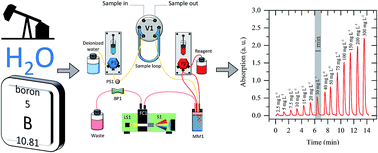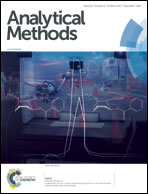Rapid determination of boron in oilfield water using a microfluidic instrument†
Abstract
We developed and validated an interference free microfluidic instrument for rapid determination of boron concentration in produced water using the carminic acid assay. Interferences from other species are eliminated by controlling crucial aspects of the kinetics and thermodynamics of the assay. The use of a microfluidic mixer improves the reaction kinetics by reducing the diffusion time. The high surface-to-volume characteristic of microchannels efficiently dissipates the heat generated by the exothermic reaction of the carminic acid with water. We incorporate a 6.5 bar back pressure element, which offsets the onset of calcium sulfate precipitation and hydrochloric acid outgassing that often disturb optical measurement for the assay when performed at atmospheric pressure. The analyzer has a measurement rate of 1 sample per min, a precision of 5%, a limit of detection of 0.16 mg L−1 at 615 nm, and a measurement range of 0–420 mg L−1. The instrument accurately measured ten water samples that were representative of fluids encountered in the oilfield when compared to ICP-MS measurements. The fast measurement rate of the instrument enables near real-time decision of the fate of produced water in the oilfield.



 Please wait while we load your content...
Please wait while we load your content...